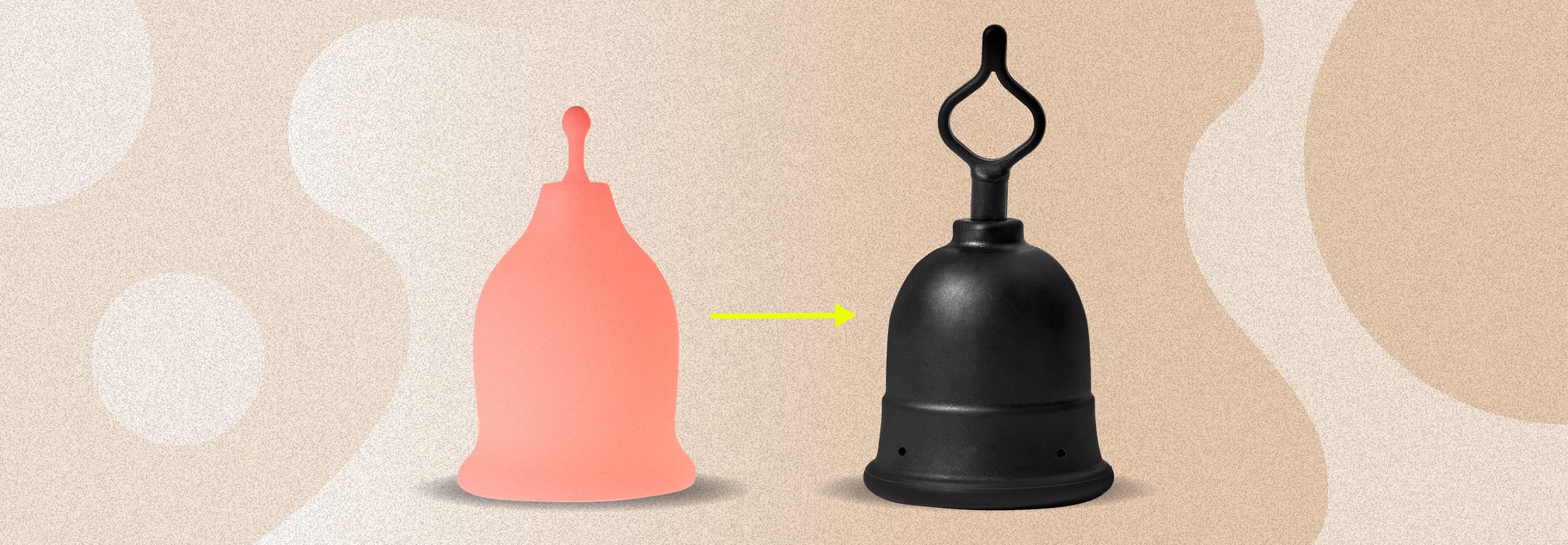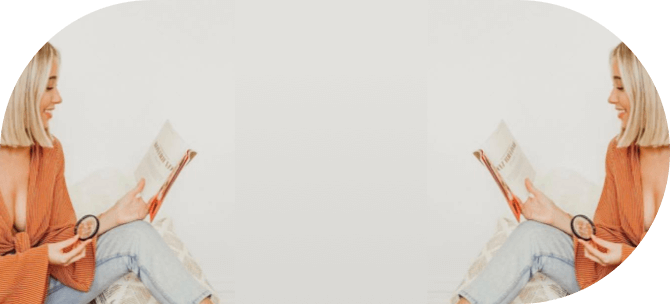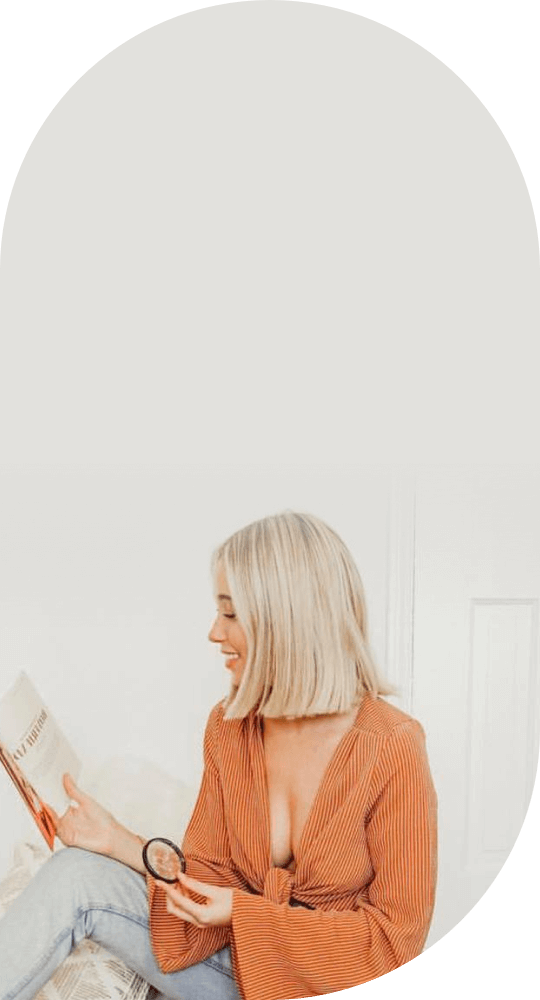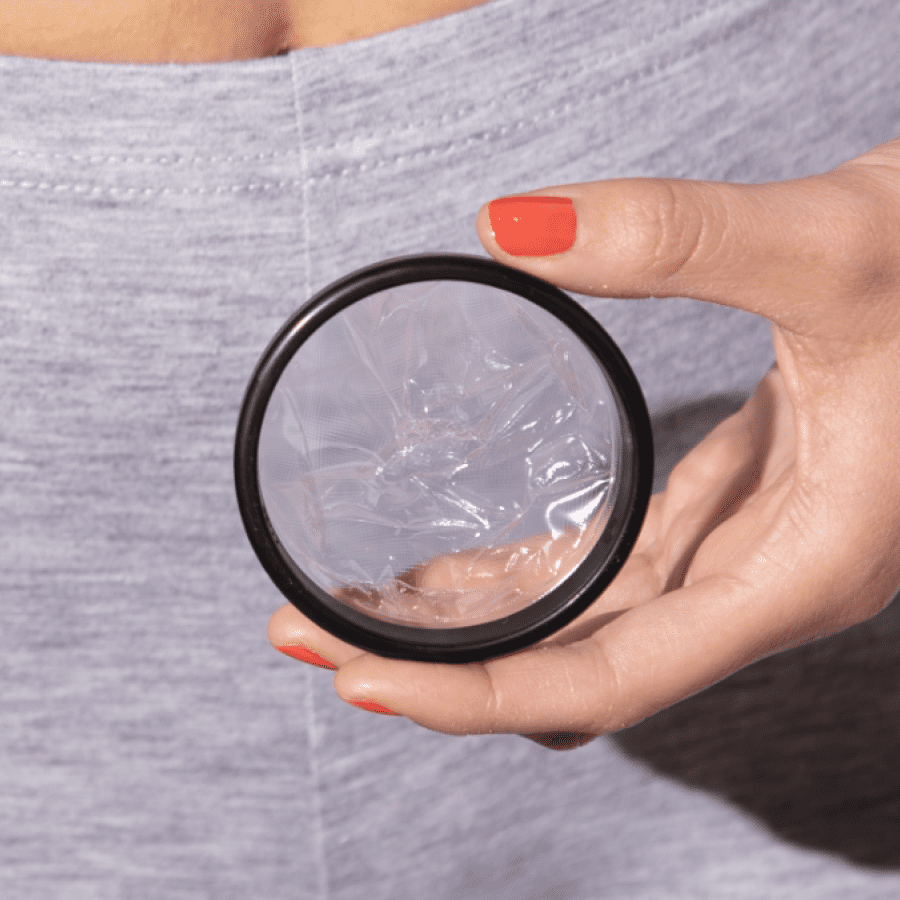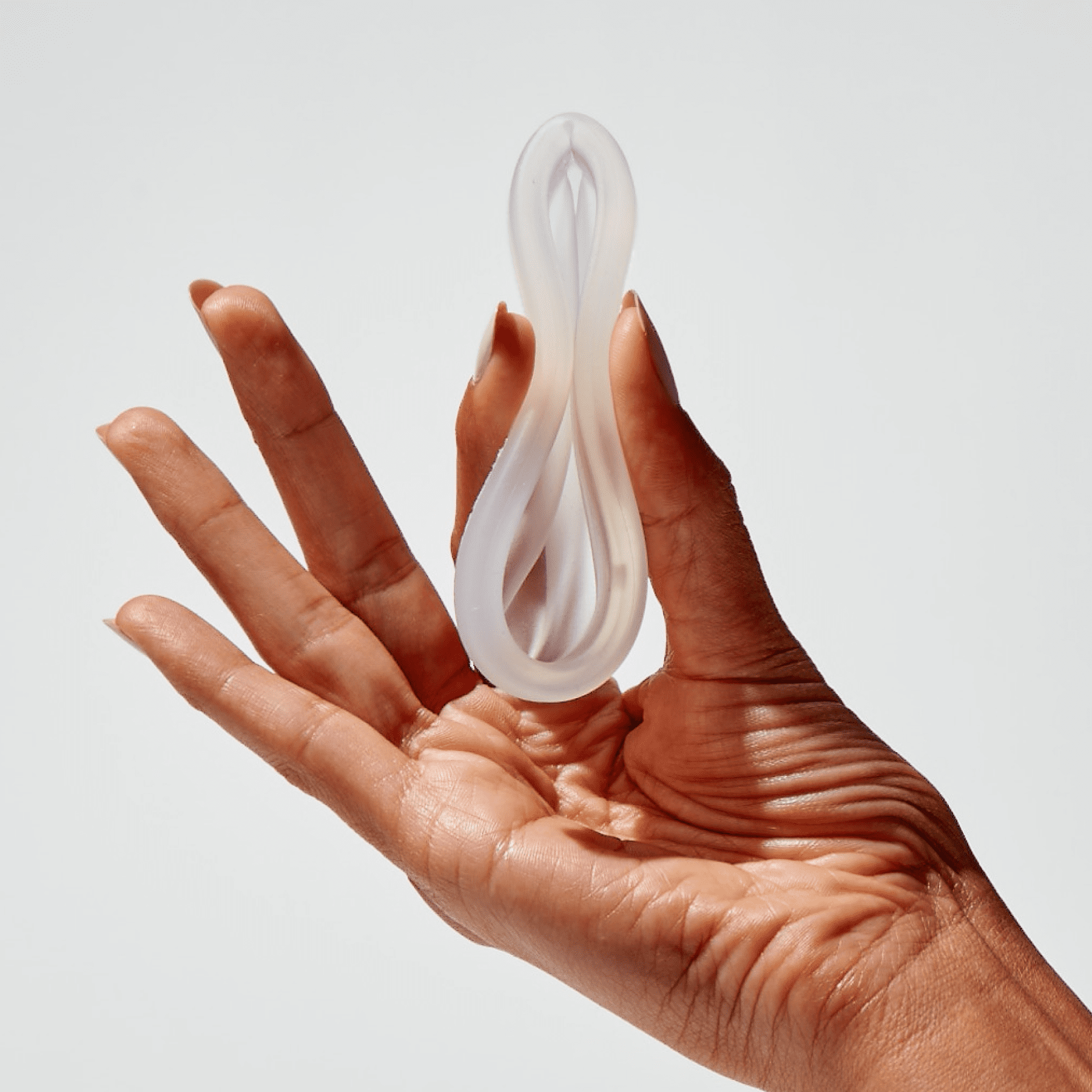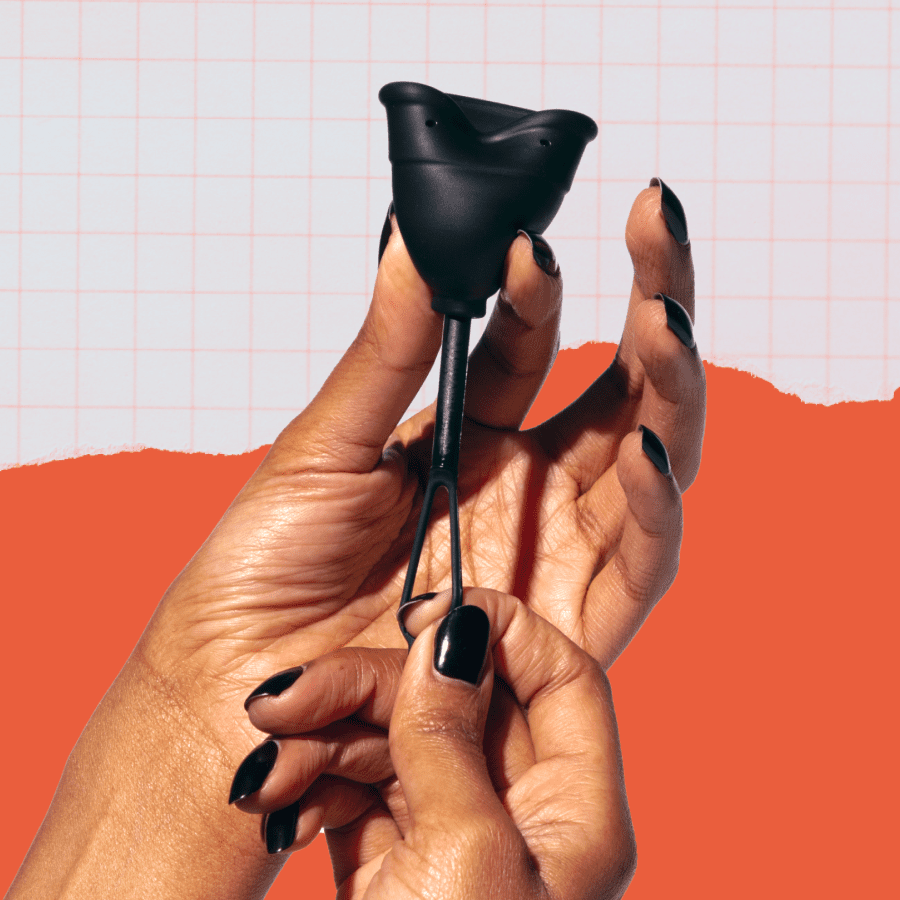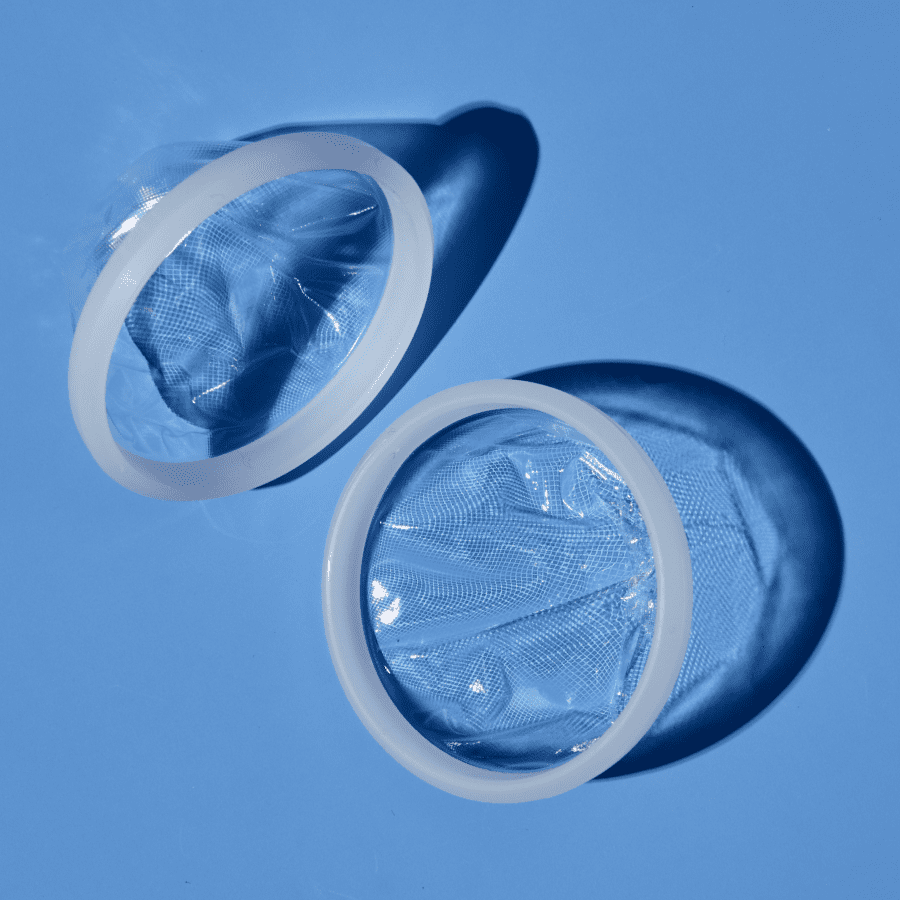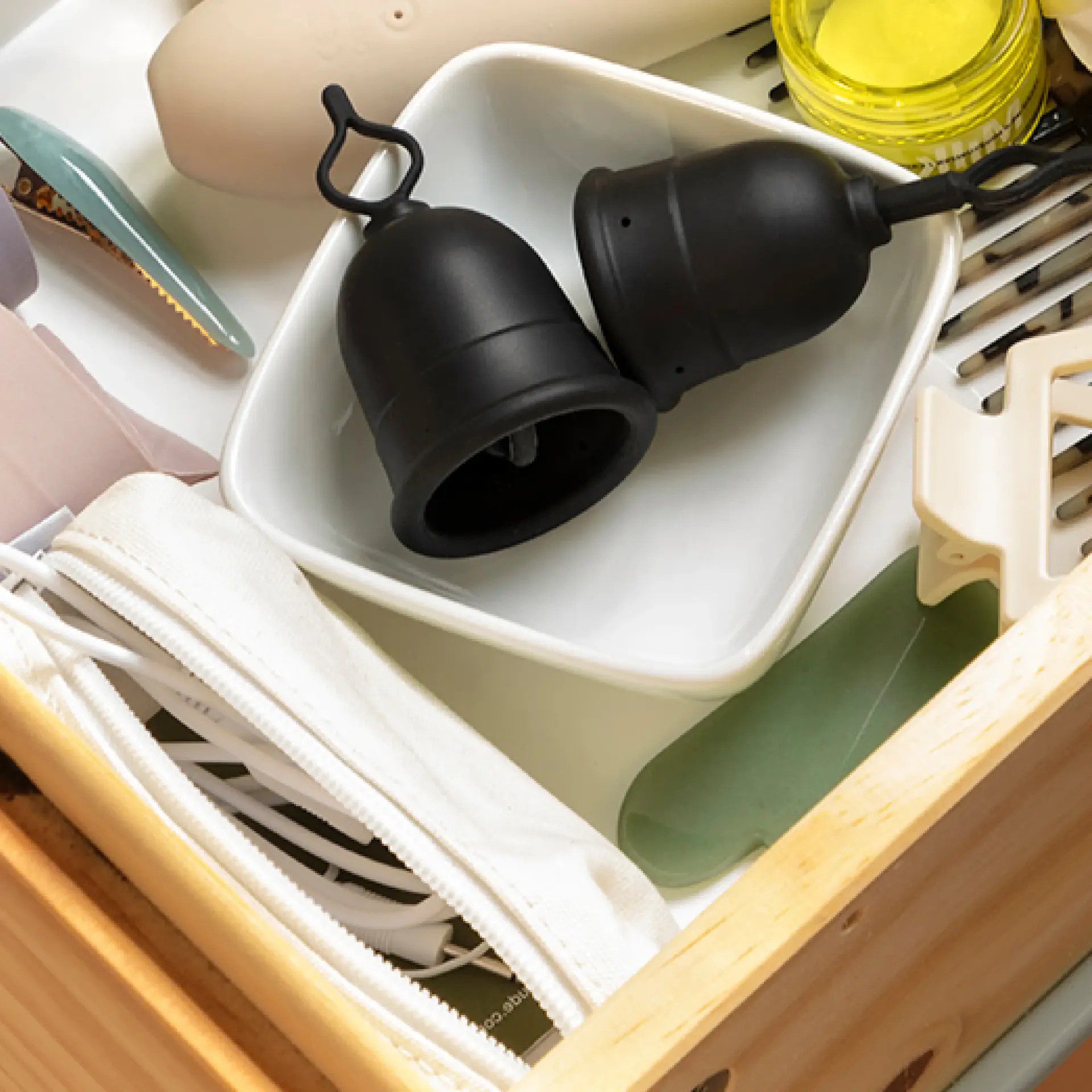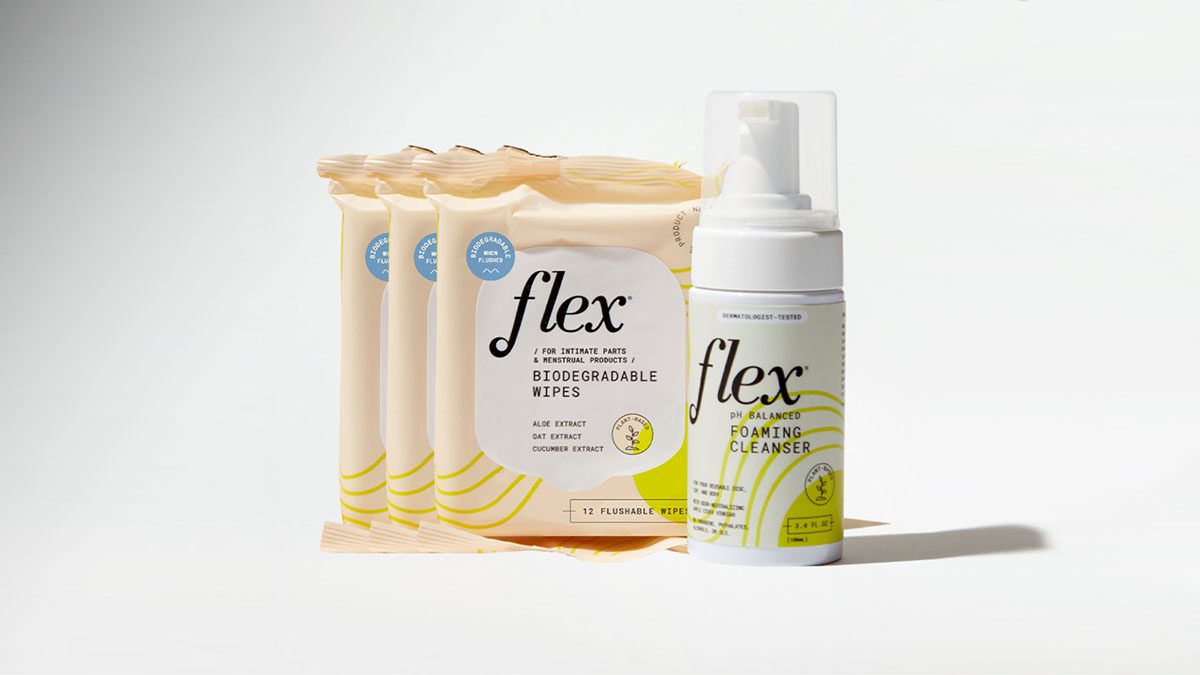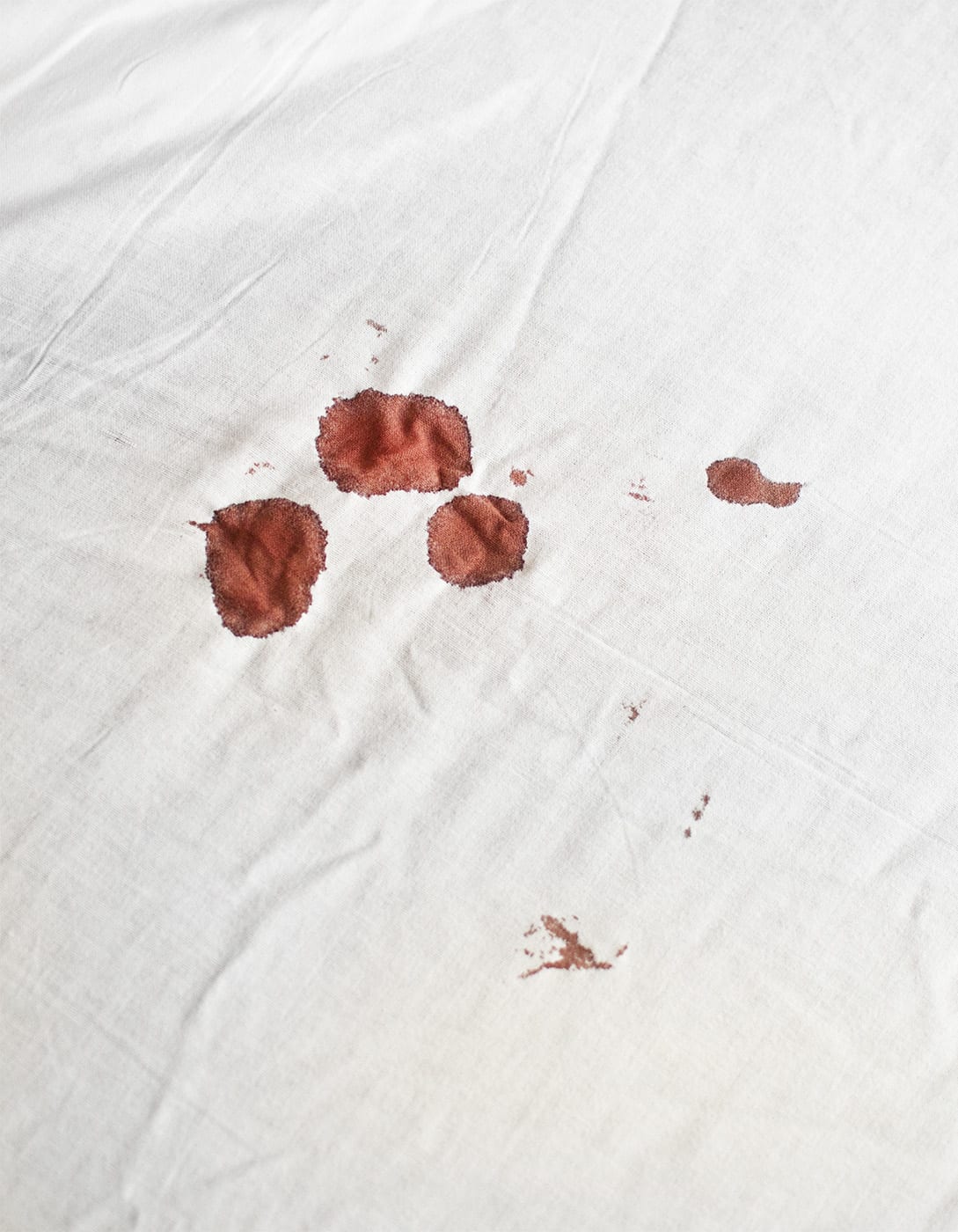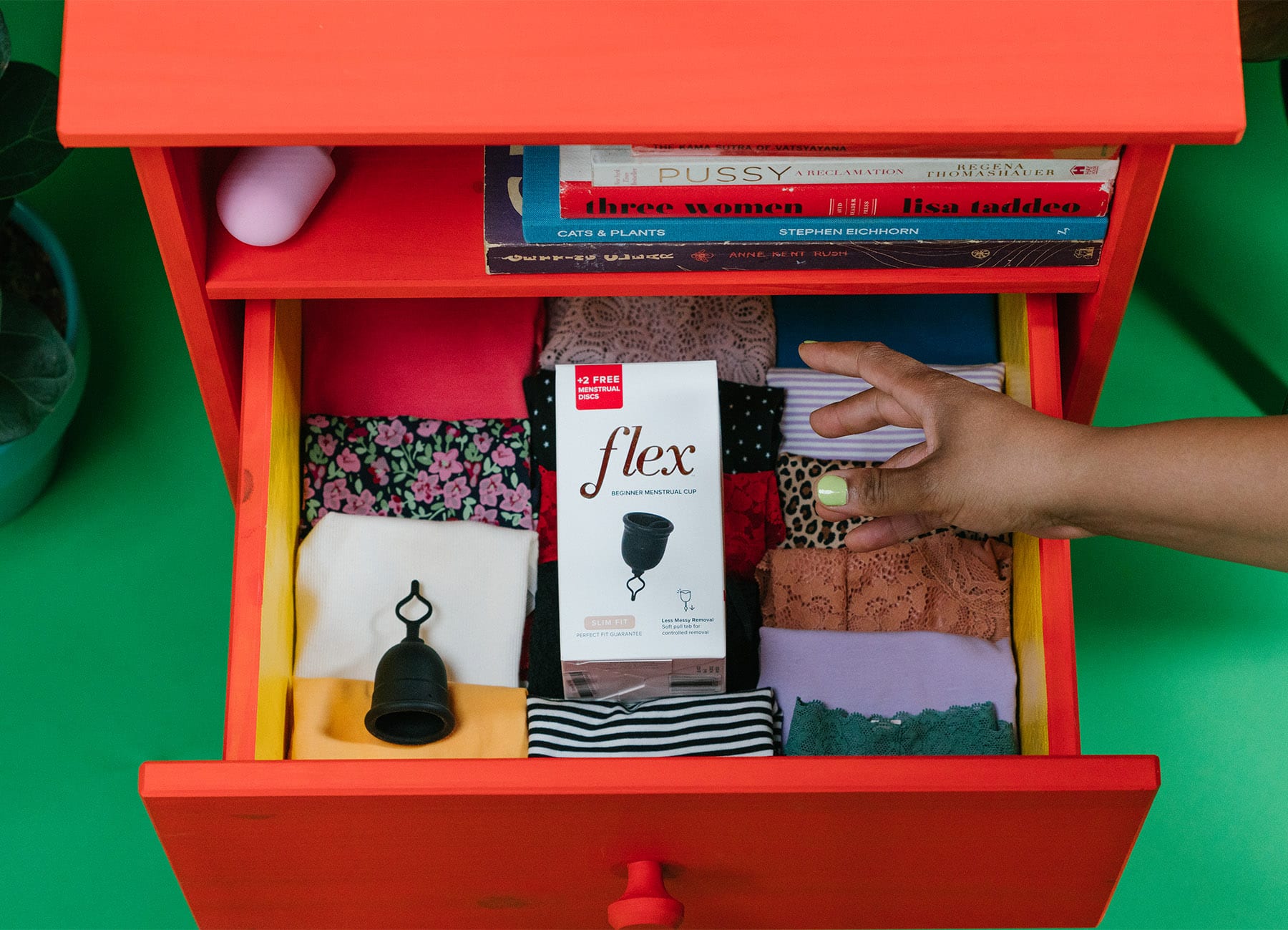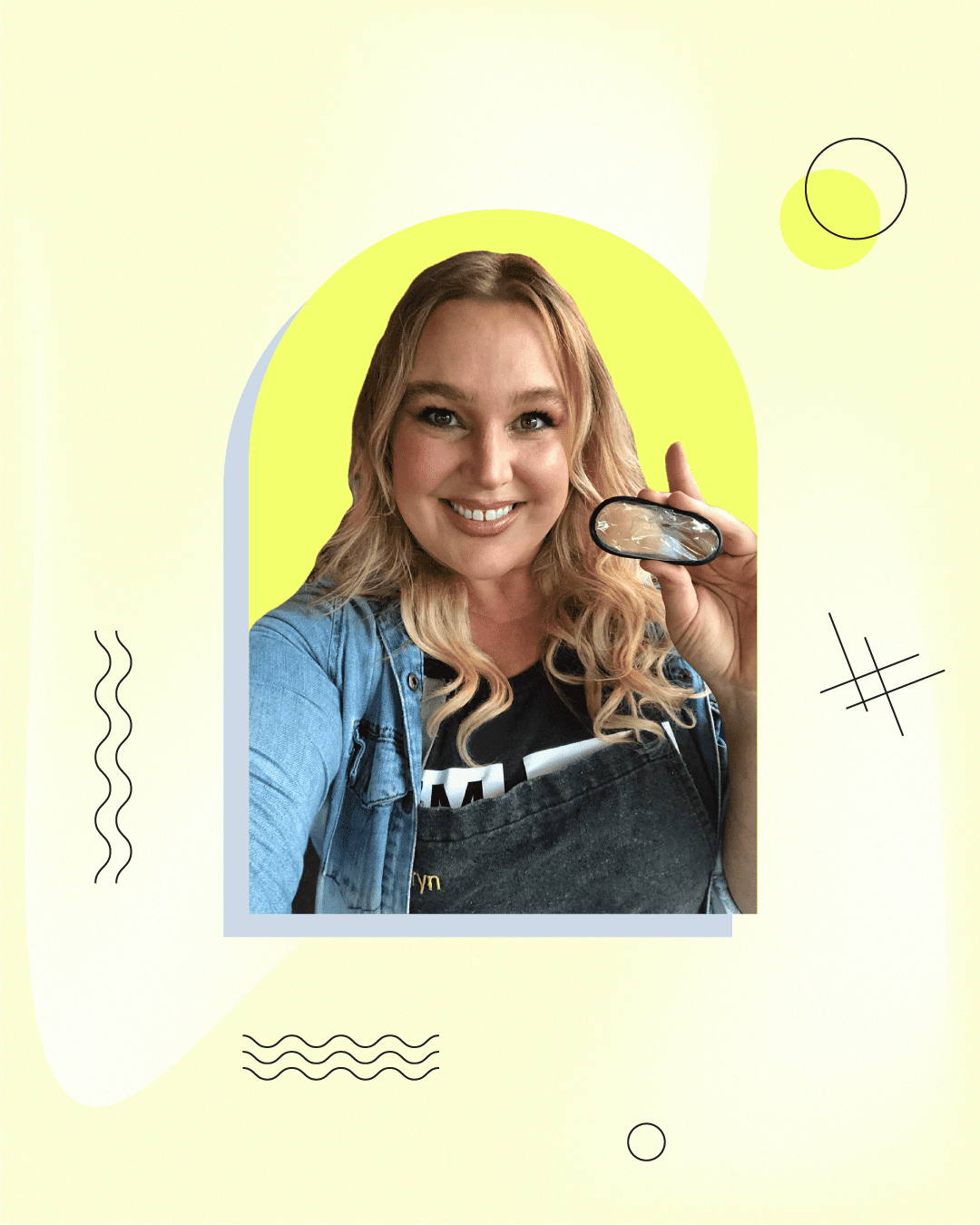Keela Cup prototype (left); Flex Cup (right)
The Flex Cup origin story
It all started so glamorously: Me in my bathroom, with my pants around my ankles, swearing to myself while trying to remove my first menstrual cup. It was month two of what ended up totaling five months of non-stop bleeding, all thanks to a recent change in birth control.
My menstrual cup seemed like it should have been a godsend through this time. Promising 12-hour wear, I’d figured I’d only have to interact with it twice per day instead of constantly, like with tampons. In reality, I was struggling.
I’m Jane Adame, co-inventor of the Flex Cup—the first sustainable period product that removes as easily as a tampon. While it was my disability that originally inspired Flex Cup’s design, the cup’s unique features have since made it one of the most popular reusable options on the market today.
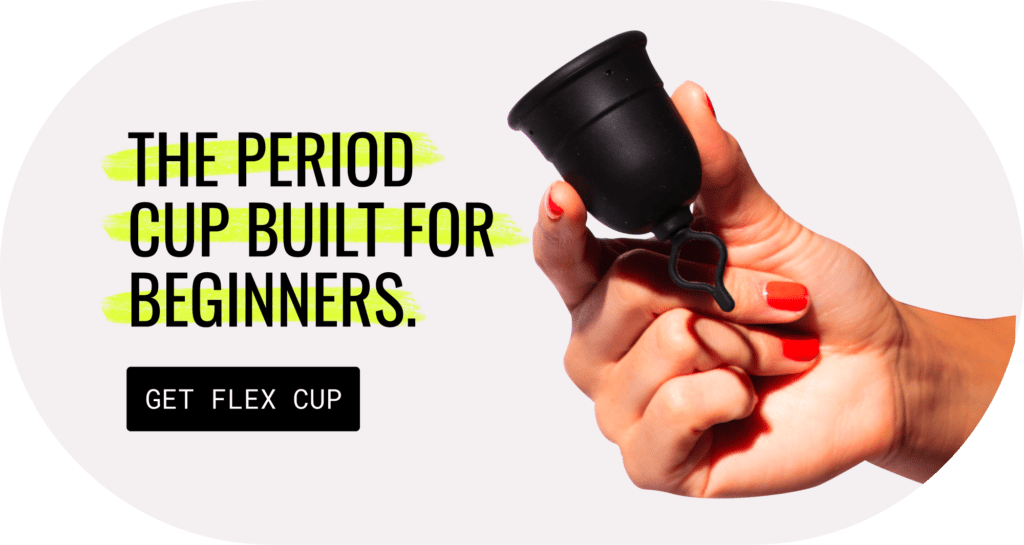
This is my story.
My menstrual cup-meets-non stop bleeding debacle took place around the same time that I learned the root cause of my increasing chronic pain and mobility limitations. I had been diagnosed with Ehlers-Danlos Syndrome (EDS).
EDS is a connective tissue disorder in which the body makes the “wrong recipe” for collagen, resulting in overly stretchy tissue. Imagine a hair tie that’s lost elasticity: That’s how my joints are held together.
As a result, I’m constantly dealing with pinched nerves thanks to bones shifting slightly out of place and muscle spasms resulting from my musculoskeletal system trying to find another way to hold itself together.
Also around this same time, I was starting to realize that my career as a salon owner and hairdresser was coming to an end. I had reached a point at which I could no longer bear weight on my feet by the end of a workday. I was looking for a wheelchair. I was looking for whatever would come next.
I knew, however, that I didn’t want my story to be a tragedy. I wanted to have a sense of ownership of whatever my next chapter would be. Thinking about all of the problems I was experiencing, I couldn’t shake the feeling that the menstrual cup—maybe a better menstrual cup—was the ticket.
II
As a very petite person, and as someone who had unknowingly lived with a disabling condition all my life, I was quite used to modifying everything around me. The world just isn’t built for women under 4’10” with aching bodies (if it were, there would be beds and step stools everywhere—just saying).
Menstrual cups seemed to promise a lot of benefits for my hurting body: No more urgent trips to the drugstore to restock tampons, no more changing said tampons multiple times per day, no more plastic wrappers or applicators ending up in landfill. Except for the part where the menstrual cup in question was causing me to experience further pain.
Back then, the people you would see touting menstrual cup usage often seemed to be relatively thin, fit, and able-bodied. These attributes certainly make it easier to reach far enough down and in between your legs to get a cup in and out. People who happen to have more weight distributed around their midsection, or those with physical disabilities and/or dexterity challenges, tend to find the body position necessary to insert and remove a menstrual cup significantly more challenging.
I had an idea, though. I wanted to find a way to make menstrual cups a more realistic option for people of all sizes and abilities.
I first shared my thoughts on menstrual cups with a salon client of mine, Tess. Tess’s partner, Andy, was a product designer in the medical devices field. Menstrual cups just so happen to fall within the “medical devices” category. Tess was intrigued, and suggested I pitch my idea to Andy.
Not long after, Andy and I began prototyping solutions. Eventually, we stumbled upon the core feature that uniquely sets our cup—now Flex Cup—apart: The pull-tab.
The hardest part of using a cup, for me, had always been removal. That’s because menstrual cups are held in place by suction. Suction is great when it comes to leak prevention, but for a person with EDS, the dexterity required to manually “break the seal” during removal was next to impossible. It’s a two-finger (and a thumb) ordeal, requiring tricky maneuvering to pinch the base and carefully pull out your cup without spilling its contents all over the floor.
This feature we had come up with took the finger maneuvering out of the equation. The “string” (pull-tab) on our cup breaks the seal for you, pulling the side of the rim down towards the cup’s center and creating an indent that breaks the suction. This allows the cup to be removed almost exactly like a tampon. Even better, the pull-tab hangs externally for easier access.
We named our new invention the Keela Cup and, as our project grew in awareness, we were able to solicit input from a slew of potential users. This helped us refine the details and make sure we were providing a solution for all people with periods—not just for myself.
The complexity of the design made our cup harder to manufacture than a typical model, and it was tough to convince senior leaders at medical device manufacturing facilities (most often able-bodied, cis men) that this was an important product to make. All the while, I had about a thousand Kickstarter backers waiting in the wings to receive their pre-ordered cups.
It was at this point in our journey that Lauren—Founder and CEO of Flex— got more involved.
III
We launched our Kickstarter campaign on December 2nd, 2017…AKA the World’s Worst Time to launch a crowdfunding campaign.
Two weeks in, our fundraiser was losing steam. We were far from our goal. Ever optimistic, I landed us a feature on Teen Vogue digital, which Lauren happened to read. She saw something in our project that many couldn’t: We had a design that meaningfully solved a problem that many cup users faced, and this product had the capability to make cup use mainstream.
As luck would have it, the Teen Vogue op-ed got a lot of eyes on our project. A miraculous comeback was made: We hit our goal! Lauren reached out to us at the campaign conclusion, offering her support. Not long after, she flew up from LA to have dinner with us. We were surprised, having expected competitors to be much more standoffish—but here she was, offering meaningful advice we would have happily paid for.
As time wore on and we faced challenges transforming our cup from design into a real-life object, we continued to develop our friendship with Lauren and leaned on her as a mentor. Eventually, we came to the decision collectively that we could serve more people if we joined forces.
So, Keela officially joined the ranks at Flex—cup, founders, and all.
Flex Cup was officially launched in 2018. Andy and I have now been part of the Flex family for over three years; today, we make up the Innovation team. We’re able to work on even more novel period care offerings and scale our user testing to make sure our products really work for as many people as possible.
As part of our inclusive design process, I’ve interviewed hundreds of menstruators about their experiences with period products over the last several years. We’ve relied heavily on their feedback when developing new additions to our product lineup— like Flex Foaming Cleanser, Flex Wipes, and our Reusable Disc. I’m proud of every item we’ve brought to market thus far.
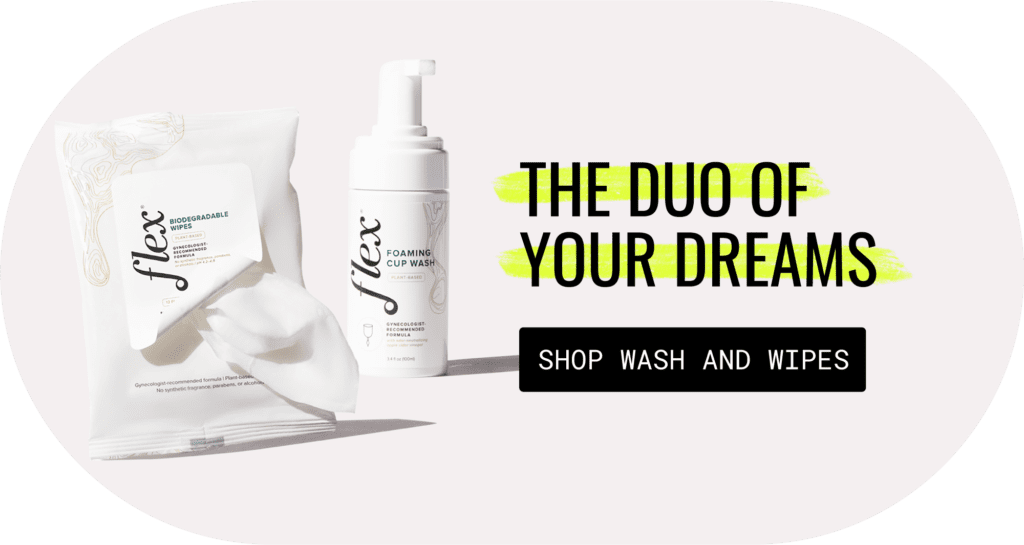
IV
So, what’s next?
One of the largest areas of daily consideration is around the significance of sustainability in the period care space. Before all this, I was trying to be a “good” menstrual cup user. I felt a personal responsibility to do better for the environment via my period product choices. Now, I feel a sense of responsibility that’s not just personal: It’s a matter of advocacy and corporate responsibility.
Menstruators should not feel burdened by the requirement to choose a specific product solely for the planet’s sake. Instead, it is the period product manufacturers whose responsibility it is to forge new pathways towards better, more sustainable products that meet the needs of all users.
In the last few years, there has been a rising ‘sustainable menstrual movement’ where some menstruators I interview who still use traditional products (i.e. pads and tampons) feel shamed for using products that add waste to the environment. As an accessibility-driven, inclusive design researcher, I am speaking up for traditional period product users to say, whatever works best for you is your right choice.
We are in the business of providing more possible “right” choices—not belittling or taking choices away, but instead educating, informing, and innovating. That’s why Flex is proud to be the only period company in the world to offer both disposable discs alongside reusable menstrual disc and cup options.
If single-use disposable products work best for someone, there is nothing wrong with that. It’s up to companies (like us) to make those single-use products better, safer, and more sustainable—for both the planet, and the people who use them. Making our existing products better while creating new and innovative solutions encompasses what I hope to do with my continued work at Flex.
I’m incredibly grateful that both Andy and Lauren took a chance on me, an ex-hairdresser turned inventor whose early career choices meant I lacked a typical college degree. Joining Flex has been life-changing: I’ve gained so much by way of work experience, career stability, and personal growth. Ultimately, it was the fact that Lauren and I shared the same deep-rooted values about what matters most that convinced me to take the leap. And it’s our shared vision that continues to inspire and motivate me every day.
Moral of the story? Look for ways to transform adversity into opportunity. Listen to your customers. Keep innovating, keep asking questions, and don’t let your period interrupt your life.
This article is informational only and is not offered as medical advice, nor does it substitute for a consultation with your physician. If you have any gynecological/medical concerns or conditions, please consult your physician.
© 2021 The Flex Company. All Rights Reserved.
